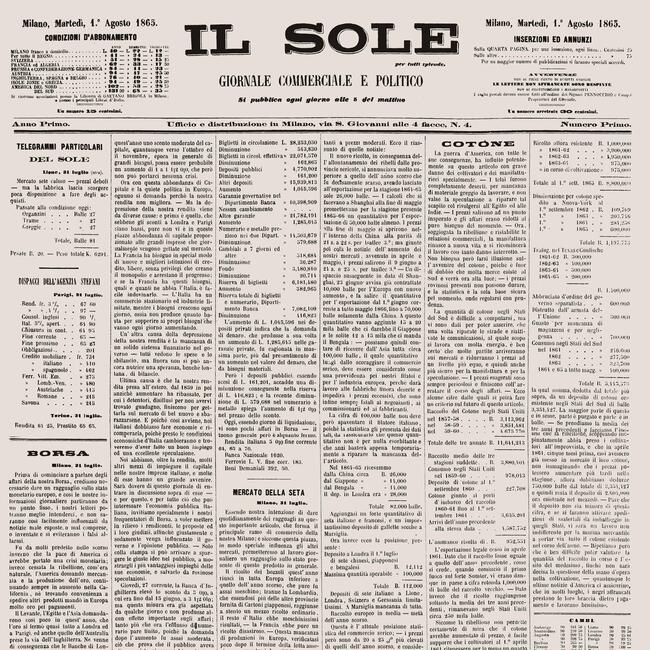The Origins
The debut of “Il Sole” at newsstands occurred in Milan on August 1, 1865. This newspaper, dedicated to economics, was an expression of a liberal and innovative bourgeoisie. It was envisioned by fabric merchant Gaetano Semenza (pictured), the Penocchio brothers, silk entrepreneurs, and publisher Francesco Vallardi. Semenza's editorial motivation began in London after meeting Giuseppe Mazzini and his group of exiles. The political inspiration of the paper was naturally liberal and reformist, initially even more radical and democratic, always favouring expressions of economic freedom. In its early years, “Il Sole” was a fiercely contested newspaper, advocating for the democratic representation of Milan in institutions, inspired by the ideas of Carlo Cattaneo.
For twenty years, “Il Sole” carried the motto “we shine for everyone.” On the front page of the August 1865 edition, it explained why: “This is a newspaper that must enlighten and ignite freedom, showing that in modern society there are advantages in which all individuals have the right to participate.” The first edition of “Il Sole” (pictured) consisted of four pages, with the first page dedicated to economic news and the second to political news. This choice already demonstrated the strong link between economic information and societal knowledge.

The Merger
“24 Ore” was launched on September 12, 1946 (pictured), coinciding with the reopening of the Milan Fair after the war, a symbolic day representing the drive for the Italian economy's recovery. This new publication was driven by the enthusiasm of Piero Colombi and featured contributions from economists such as Libero Lenti, Roberto Tremelloni, Federico Maria Pacces, and a very young Eugenio Scalfari. The columns of “24 Ore” were inspired by liberalism and a deep scepticism towards state interventionism. Over time, “Il Sole” and “24 Ore” increasingly aligned in their editorial direction and advocacy for economic liberalization.

The merger of the two publications occurred naturally, leading to the first issue of “Sole 24 Ore” hitting Italian newsstands on November 9, 1965 (pictured). The title of the editorial in the inaugural issue under Mauro Masone’s direction, “Work Tool,” was emblematic and forward thinking. It emphasized the significance and utility of being well-informed, not just for knowledge’s sake but to make informed decisions in business and professional practices.

From the Turn of the Eighties to 2000
Under the long tenure of Gianni Locatelli, beginning in May 1983, Il Sole 24 Ore guided the profound transformation of the Italian economy by significantly expanding and innovating its informational content. These years saw a rapid increase in sales, establishing Il Sole 24 Ore as a publishing phenomenon and a European leader in circulation among economic-financial newspapers. The newspaper increasingly appealed to a broad and diverse audience, who regarded it as a comprehensive source of information. In 1983, the cultural supplement “Domenica” was introduced, remaining a unique feature in the Italian cultural landscape for a long time. The cultural supplement “Lunedi” edition was launched in 1986, followed by the autonomous section “Finanza e Mercati” in 1989, which covered not only the Italian stock exchange but also international finance and all savings products. The 1990s marked a shift towards multimedia, with the addition of the website ilsole24ore.com, the Radiocor news agency, the news&talk station Radio 24, professional publications, and databases. The 2000s brought challenging times for the global economy, including the events of September 11th and the collapse of Lehman Brothers. In response, Plus24 was launched, a weekly dedicated to financial education, savings, and investments for all savers. These were years of significant transformation, culminating in the launch of NOVA in 2005, a continuously updated window on innovation.
The “Sistema Sole” and the Leap into the New Millennium
The information system of Il Sole 24 Ore is continually evolving, characterized in recent years by its multimedia integration, leveraging the full potential offered by digital technology. The new app for the newspaper, Radio 24's podcasts, presence on social networks, the development of data journalism, the use of artificial intelligence in databases, presence on emerging platforms, new voice-activated device sleading up to the new television channel Radio24-IlSole24OreTv, and a multi-device content consumption approach focused on mobile-first are all parts of a development increasingly centred on innovation in the world of information. This multimedia system prioritizes informational quality and content certification as its hallmark.